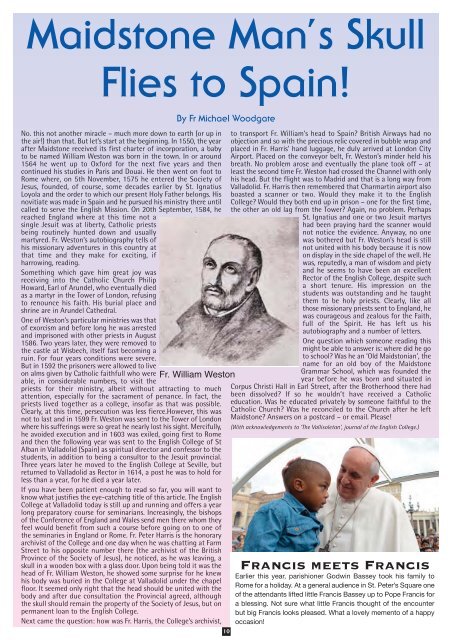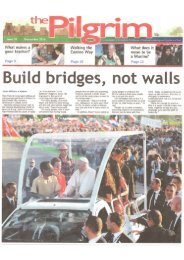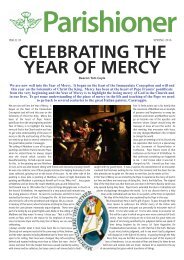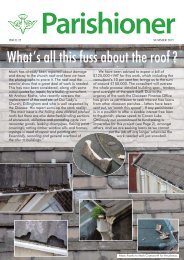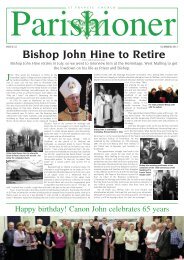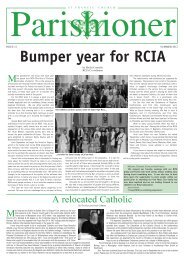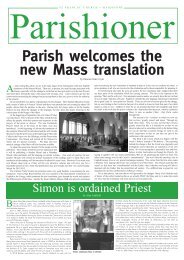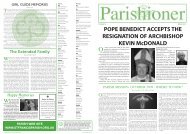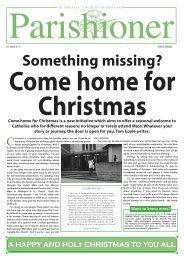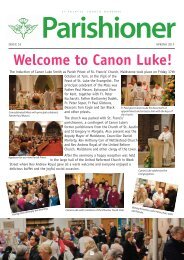The Parishioner - Edition 23
The Parishioner is the quarterly publication of St. Francis' Catholic Parish, Maidstone.
The Parishioner is the quarterly publication of St. Francis' Catholic Parish, Maidstone.
You also want an ePaper? Increase the reach of your titles
YUMPU automatically turns print PDFs into web optimized ePapers that Google loves.
Maidstone Man’s Skull<br />
Flies to Spain!<br />
By Fr Michael Woodgate<br />
No. this not another miracle – much more down to earth (or up in<br />
the air!) than that. But let’s start at the beginning. In 1550, the year<br />
after Maidstone received its first charter of incorporation, a baby<br />
to be named William Weston was born in the town. In or around<br />
1564 he went up to Oxford for the next five years and then<br />
continued his studies in Paris and Douai. He then went on foot to<br />
Rome where, on 5th November, 1575 he entered the Society of<br />
Jesus, founded, of course, some decades earlier by St. Ignatius<br />
Loyola and the order to which our present Holy Father belongs. His<br />
novitiate was made in Spain and he pursued his ministry there until<br />
called to serve the English Mission. On 20th September, 1584, he<br />
reached England where at this time not a<br />
single Jesuit was at liberty, Catholic priests<br />
being routinely hunted down and usually<br />
martyred. Fr. Weston’s autobiography tells of<br />
his missionary adventures in this country at<br />
that time and they make for exciting, if<br />
harrowing, reading.<br />
Something which gave him great joy was<br />
receiving into the Catholic Church Philip<br />
Howard, Earl of Arundel, who eventually died<br />
as a martyr in the Tower of London, refusing<br />
to renounce his faith. His burial place and<br />
shrine are in Arundel Cathedral.<br />
One of Weston’s particular ministries was that<br />
of exorcism and before long he was arrested<br />
and imprisoned with other priests in August<br />
1586. Two years later, they were removed to<br />
the castle at Wisbech, itself fast becoming a<br />
ruin. For four years conditions were severe.<br />
But in 1592 the prisoners were allowed to live<br />
on alms given by Catholic faithfull who were Fr. William Weston<br />
able, in considerable numbers, to visit the<br />
priests for their ministry, albeit without attracting to much<br />
attention, especially for the sacrament of penance. In fact, the<br />
priests lived together as a college, insofar as that was possible.<br />
Clearly, at this time, persecution was less fierce.However, this was<br />
not to last and in 1599 Fr. Weston was sent to the Tower of London<br />
where his sufferings were so great he nearly lost his sight. Mercifully,<br />
he avoided execution and in 1603 was exiled, going first to Rome<br />
and then the following year was sent to the English College of St<br />
Alban in Valladolid (Spain) as spiritual director and confessor to the<br />
students, in addition to being a consultor to the Jesuit provincial.<br />
Three years later he moved to the English College at Seville, but<br />
returned to Valladolid as Rector in 1614, a post he was to hold for<br />
less than a year, for he died a year later.<br />
If you have been patient enough to read so far, you will want to<br />
know what justifies the eye-catching title of this article. <strong>The</strong> English<br />
College at Valladolid today is still up and running and offers a year<br />
long preparatory course for seminarians. Increasingly, the bishops<br />
of the Conference of England and Wales send men there whom they<br />
feel would benefit from such a course before going on to one of<br />
the seminaries in England or Rome. Fr. Peter Harris is the honorary<br />
archivist of the College and one day when he was chatting at Farm<br />
Street to his opposite number there (the archivist of the British<br />
Province of the Society of Jesus), he noticed, as he was leaving, a<br />
skull in a wooden box with a glass door. Upon being told it was the<br />
head of Fr. William Weston, he showed some surprise for he knew<br />
his body was buried in the College at Valladolid under the chapel<br />
floor. It seemed only right that the head should be united with the<br />
body and after due consultation the Provincial agreed, although<br />
the skull should remain the property of the Society of Jesus, but on<br />
permanent loan to the English College.<br />
Next came the question: how was Fr. Harris, the College’s archivist,<br />
10<br />
to transport Fr. William’s head to Spain? British Airways had no<br />
objection and so with the precious relic covered in bubble wrap and<br />
placed in Fr. Harris’ hand luggage, he duly arrived at London City<br />
Airport. Placed on the conveyor belt, Fr. Weston’s minder held his<br />
breath. No problem arose and eventually the plane took off – at<br />
least the second time Fr. Weston had crossed the Channel with only<br />
his head. But the flight was to Madrid and that is a long way from<br />
Valladolid. Fr. Harris then remembered that Charmartin airport also<br />
boasted a scanner or two. Would they make it to the English<br />
College? Would they both end up in prison – one for the first time,<br />
the other an old lag from the Tower? Again, no problem. Perhaps<br />
St. Ignatius and one or two Jesuit martyrs<br />
had been praying hard the scanner would<br />
not notice the evidence. Anyway, no one<br />
was bothered but Fr. Weston’s head is still<br />
not united with his body because it is now<br />
on display in the side chapel of the well. He<br />
was, reputedly, a man of wisdom and piety<br />
and he seems to have been an excellent<br />
Rector of the English College, despite such<br />
a short tenure. His impression on the<br />
students was outstanding and he taught<br />
them to be holy priests. Clearly, like all<br />
those missionary priests sent to England, he<br />
was courageous and zealous for the Faith,<br />
full of the Spirit. He has left us his<br />
autobiography and a number of letters.<br />
One question which someone reading this<br />
might be able to answer is: where did he go<br />
to school? Was he an ‘Old Maidstonian’, the<br />
name for an old boy of the Maidstone<br />
Grammar School, which was founded the<br />
year before he was born and situated in<br />
Corpus Christi Hall in Earl Street, after the Brotherhood there had<br />
been dissolved? If so he wouldn’t have received a Catholic<br />
education. Was he educated privately by someone faithful to the<br />
Catholic Church? Was he reconciled to the Church after he left<br />
Maidstone? Answers on a postcard – or email. Please!<br />
(With acknowledgements to ‘<strong>The</strong> Vallisoletan’, journal of the English College.)<br />
Francis meets Francis<br />
Earlier this year, parishioner Godwin Bassey took his family to<br />
Rome for a holiday. At a general audience in St. Peter’s Square one<br />
of the attendants lifted little Francis Bassey up to Pope Francis for<br />
a blessing. Not sure what little Francis thought of the encounter<br />
but big Francis looks pleased. What a lovely memento of a happy<br />
occasion!


